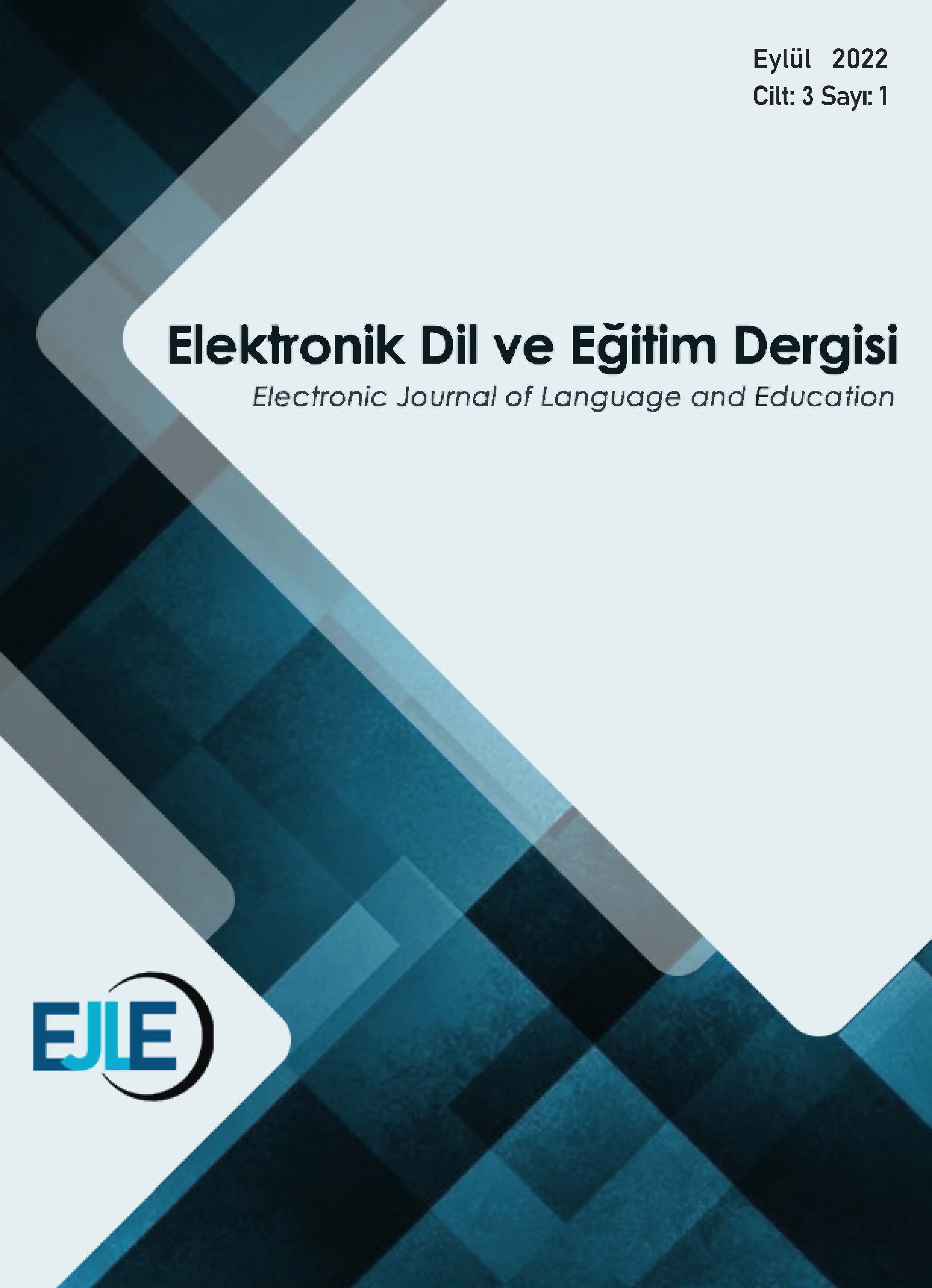Ortaokul 5, 6, 7 ve 8. Sınıf Türkçe Ders Kitaplarındaki Metinlerin Söz Sanatları Bakımından İncelenmesi
Author :
Abstract
Bu çalışmanın amacı; Türkçe Dersi Öğretim Programı’nda (2019) yer alan söz sanatlarının, Türkçe ders kitaplarındaki metinlerde ne sıklıkta geçtiğini sınıf düzeyi, tema ve metin türü bağlamında incelemektir. Çalışma nitel araştırmanın doğasına uygun şekilde yürütülmüş, çalışmada verilerin toplanmasında doküman analizi tekniği kullanılmıştır. Araştırma materyali olarak, 2021-2022 eğitim-öğretim yılında Millî Eğitim Bakanlığı tarafından okutulan Türkçe ders kitapları seçilmiştir. Araştırmanın analizleri programda yer alan söz sanatları, kitapların sınıf düzeyi, temalar ve metin türleri esas alınarak yürütülmüştür. Yapılan analiz sonucunda, söz sanatlarının sınıf seviyelerine ve kitapların yayınlarına göre farklılık gösterdiği tespit edilmiştir. 5. sınıfta kullanılan tek kitapta toplam 106, 6. sınıfta kullanılan üç kitapta toplam 385, 7. sınıfta kullanılan üç kitapta toplam 404 ve 8. sınıfta kullanılan tek kitapta toplam 374 söz sanatına ulaşılmıştır. İnceleme neticesinde söz sanatları arasında en çok benzetme ve kişileştirme sanatına en az ise abartma sanatına rastlanılmıştır. Bunun yanında ders kitaplarında yer alan metinlerde kullanılmış olan söz sanatlarının türlerinin ve metinlerde kullanımlarının 5. sınıftan 8. sınıfa doğru artarak devam ettiği görülmüştür. Ancak ilgili söz sanatları ayrı ayrı değerlendirildiğinde söz konusu durumun farklılaştığı saptanmıştır. Söz sanatlarının metinlerdeki sıklıklarına bakıldığında ise metin türlerinin son derece etkili olduğu görülmektedir. Kişileştirme, benzetme ve konuşturma sanatlarının roman, hikâye, fabl ve anı türünde; konuşturma ve kişileştirme sanatlarının fabl türünde; tezat sanatının deneme türünde; abartma sanatının ise destan ve efsane türünde sıklık olarak fazla olması bu sonucu desteklemektedir. Ayrıca şiir türündeki metinlerde düz yazı türlerinde olduğu gibi kişileştirme ve benzetme sanatının sıklıkla kullanıldığı tespit edilmiştir.
Keywords
Abstract
The aim of this study is examining how often the rhetoric in Turkish Course Curriculum (2019) are mentioned in texts in Turkish lesson books in the context of grade level, theme and type of text. The study was conducted in accordance with the nature of the qualitative research and the document analysis technique was used to collect the data. As the research material, Turkish lesson books taught by the Ministry of National Education in the 2021-2022 academic year were selected. The analyzes of the research carried out based on rhetoric in the curriculum, the grade level of the lesson books, themes and types of text. As a result of the analysis, it was determined that rhetoric differ according to the grade levels and the publications of books. A total of 106 rhetoric were found in a single book used in the 5th grade, a total of 385 rhetoric in the three books used in the 6th grade, a total of 404 rhetoric in the three books used in the 7th grade and a total of 374 rhetoric in a single book used in the 8th grade. Among the rhetoric reached, simile and personification were used the most, and art of exaggeration was found the least. In addition, it has been observed that the types of rhetoric used in texts in lesson books and rhetoric's use in texts continue to increase from the 5th of grade the 8th grade. However, when the relevant rhetoric were evaluated separately, it was determined that the situation in question was different. When the frequencies of rhetoric in texts are examined, it is seen that the types of texts are extremely effective. The fact that personification, simile and speech are in novels, stories, fables and memoirs; speech and personification in fables, the art of contrast in essays, and the art of exaggeration is more frequent in epics and legends supports this result. It has also been found that personification and simile are frequently used in poetry as in the types of prose.
Keywords
- Altıkulaçoğlu, S. (2010). Yabancı dil sınıflarında eşdizimli sözcük öğretimi ve anadilinin rolü. Dil Dergisi, 148, 37-52.
- Aslan, C., Doğan Güldenoğlu, B. N. ve Altuntaş, İ. (2018). Türkçe ders kitaplarındaki söz sanatlarıyla ilgili sorular ve etkinlikler üzerine bir inceleme. Electronic Turkish Studies, 13(28), 47-66.
- Çeçen, M. A. ve Çiftçi, Ö. (2007). İlköğretim 6. sınıf Türkçe ders kitaplarında yer alan metinlerin tür ve tema açısından incelenmesi. Milli Eğitim Dergisi, 173, 39-49.
- Çiftçi, M. ve Kaplan, K. (2020). Karikatürde yer alan kırılma çizgilerinin söz sanatları öğretimine etkisi. Ana Dili Eğitimi Dergisi, 8(2), 509-527.
- Emiroğlu, S. (2012). İlköğretim ikinci kademe Türkçe derslerinde söz sanatlarının öğretimi, Türkçenin eğitimi–öğretimi üzerine çalışmalar. Ankara: Pegem Akademi Yayınları.
- Kaplan, K. (2010). İlköğretim 6, 7, 8. sınıf Türkçe ders kitaplarındaki edebî sanatların metni anlama ve anlatmadaki yeri (Yayımlanmamış yüksek lisans tezi). Erzincan Binali Yıldırım Üniversitesi, Erzincan.
- Keskinoğlu, G. ve Ökten, C. E. (2021). Ortaokul Türkçe ders kitaplarında söz sanatlarının metaforlarla öğretilmesi. Uluslararası Türkçe Edebiyat Kültür Eğitim (TEKE) Dergisi, 10(1), 206-221.
- MEB. (2019). Ortaokul ve İmam Hatip Ortaokulu Türkçe 5. Sınıf Ders Kitabı. Ankara: Anıttepe Yayıncılık.
- MEB. (2019). Ortaokul ve İmam Hatip Ortaokulu Türkçe 6. Sınıf Ders Kitabı. Ankara: Ata
- MEB. (2019a). Ortaokul ve İmam Hatip Ortaokulu Türkçe 6. Sınıf Ders Kitabı. Ankara: Milli Eğitim Bakanlığı Yayınları.
- MEB. (2019a). Ortaokul ve İmam Hatip Ortaokulu Türkçe 7. Sınıf Ders Kitabı. Ankara: Milli
- MEB. (2019b). Ortaokul ve İmam Hatip Ortaokulu Türkçe 6. Sınıf Ders Kitabı. Ankara: Milli
- MEB. (2019b). Ortaokul ve İmam Hatip Ortaokulu Türkçe 7. Sınıf Ders Kitabı. Ankara: Milli
- MEB. (2019). Ortaokul ve İmam Hatip Ortaokulu Türkçe 7. Sınıf Ders Kitabı. Ankara: Özgün
- MEB. (2019). Ortaokul ve İmam Hatip Ortaokulu Türkçe 8. Sınıf Ders Kitabı. Ankara: Milli
- MEB. (2019). Türkçe Dersi Öğretim Programı (İlkokul ve Ortaokul 1, 2, 3, 4, 5, 6, 7 ve 8. Sınıflar). Ankara: Millî Eğitim Bakanlığı.
- Solak, M. ve Yaylı, D. (2009). İlköğretim ikinci kademe Türkçe ders kitaplarının türler açısından incelenmesi. Journal of International Social Research, 2(9), 444-453.
- Şimşek, H. ve Yıldırım, A. (2013). Sosyal bilimlerde bilimsel araştırma yöntemleri (9 b.). Ankara: Seçkin Yayıncılık.
